bicycle, node, network, design
14 September 2016, 10:25
For a full transcript, read on.
ring ring
There are two things that you need to know about me. The first is that I am dutch and the second is that I am becoming a sentimental old fool. I combine the two when I do cycling holidays in Holland:
 my partner Carmen leads the way
my partner Carmen leads the way
For this we use the fietsroutenetwerk, the bicycle route network of the Netherlands. This was designed for recreational cycling in the countryside. It was rolled out between 2003 and 2012. The network is point‐to‑point:
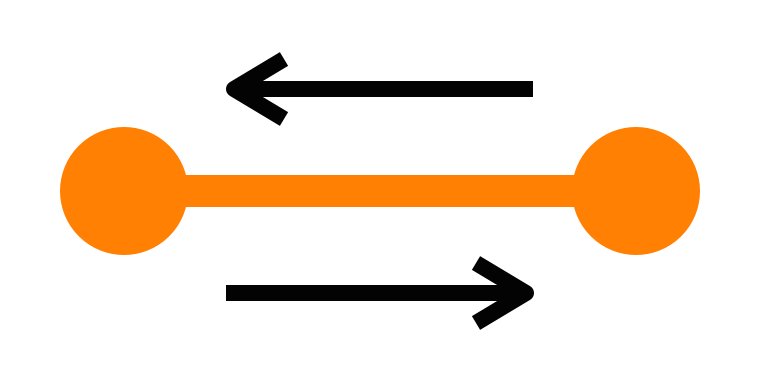
Between two neighbouring nodes there is complete signage—with no gaps—to get you from one to the other. And this in both directions. Here are some of these signs:
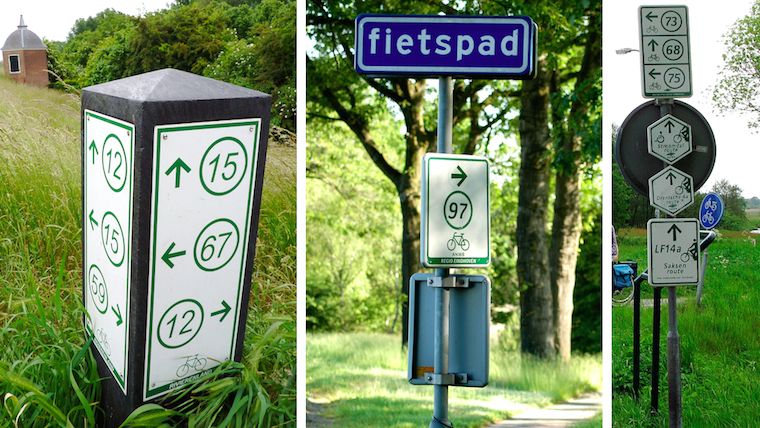 sources: fietsen op de fiets,
het groene woud,
gps.nl
sources: fietsen op de fiets,
het groene woud,
gps.nl
The implicit promise is that these are nice routes. That means: away from cars as much as possible. And scenic—through fields, heath and forrest.
Using the nodes, local networks have been designed and built:
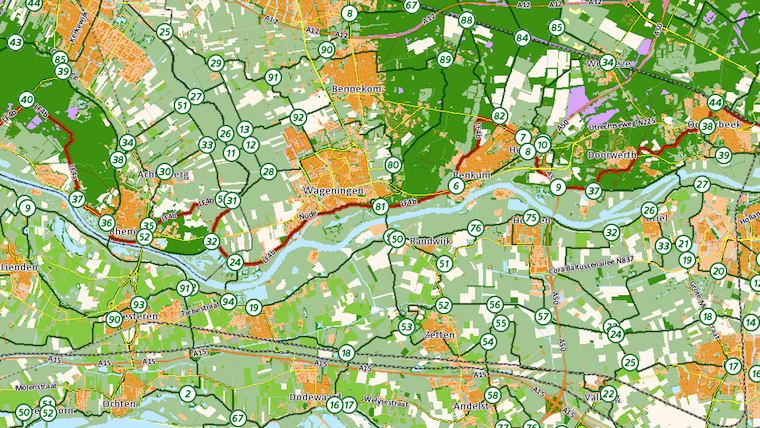
These networks are purely infrastructural; there is no preconception of what is ‘proper’ or ‘typical’ usage. They accommodate routes of any shape and any length.
At every node, one finds a local map, with the network:
 source: wikimedia commons
source: wikimedia commons
It can be used for planning, reference and simply reassurance. Besides that, there are old‑fashioned maps and plenty of apps and websites for planning and sharing of routes.
The local networks were knitted together to form a national network:
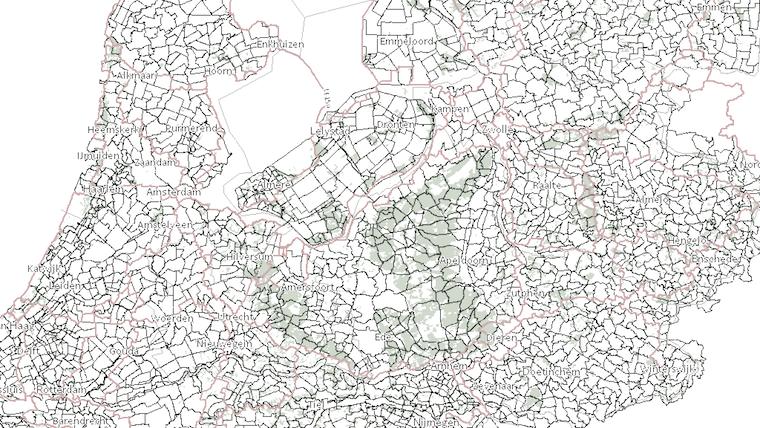
Looking at this map I see interesting differences in patterns and densities. I don’t think this only reflects the geography, but also the character of the locals; what they consider proper cycling infrastructure and scenic routes.
The network was not always nation-wide. It was rolled out over a period of nine years, one local network at the time. I still remember crossing a province border and (screech!) there was no more network. It was back to old‑fashioned map reading and finding the third street on the left.
not invented here
I was shocked to find out that the Dutch did not invent this network system. We have to go back to the 1980s, north‐east Belgium: all the coal mines are closing. Mining engineer Hugo Bollen proposes to create a recreational cycling network, in order to initiate economic regeneration of the region. Here’s Hugo:
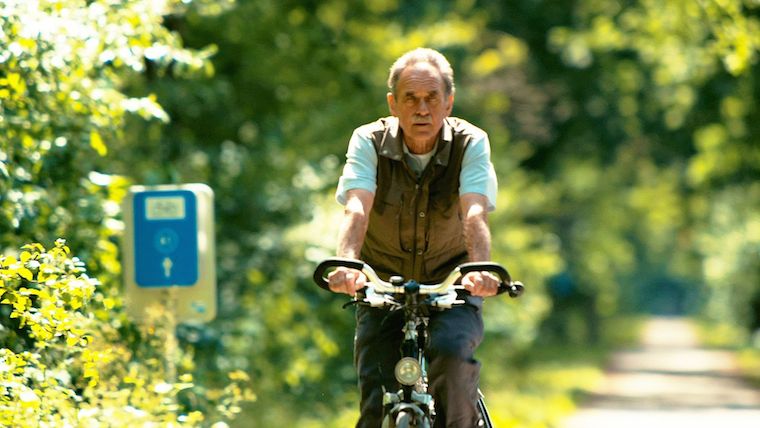 source: toerisme limburg
source: toerisme limburg
He designed the network rules explained in this blog post. The Belgians actually had to build(!) all of the cycling infrastructure, so it took them to 1995 to open the first local network. It now brings in 16.5 million Euro a year to the region.
how many?
I got curious about the total number of network nodes in Holland. I could not find this number on the internet. The net is really quite short on stats and data of the cycling network. So I needed to find out by myself. What I did was take one of my maps—
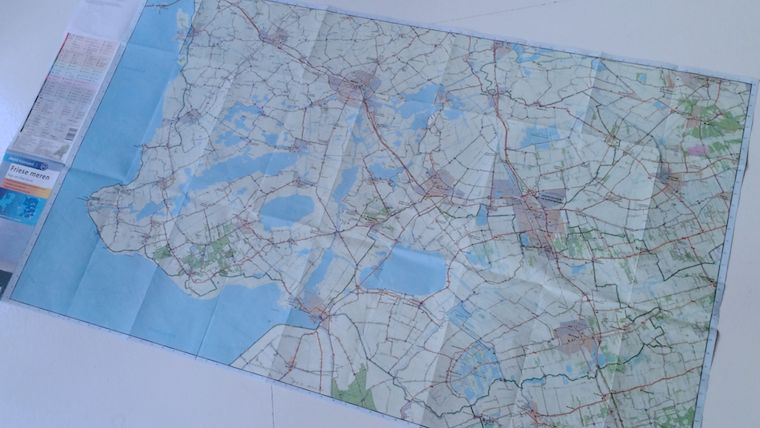
And I counted all the nodes—there were 309. I multiplied this with the number of maps that cover all of Holland. Then I took 75% of that number to deal with map overlaps and my own over‐enthusiasm. The result: I estimate that the dutch network consists of 9270 nodes.
in awe
The reason I got curious about that number is that every time I use the network, I am impressed by a real‐genius design decision (and I don’t get to say that very often). It makes all the difference, when using the network in anger.
All these nearly‐ten thousand nodes are identified by a two‑digit number. Not the four (or more future‐proof, five) one would expect. All the nodes are simply numbered 1 through 99, and then they start at one again. And shorter is much better:
 source: recreatieschap westfriesland
source: recreatieschap westfriesland
Two digits is much faster to read and write down. It is easier to memorise, short‐term. It is instant to compare and confirm. Remember, most of these actions are performed while riding a bike at a nice cruising speed.
but…
Pushing through this two‑digit design must have been asking for trouble. Most of us can just imagine the bike‐shedding: ‘what if cyclists really need to be able to uniquely identify a node in the whole nation?’ Or: ‘will cyclists get confused by these repeating numbers?’
This older cycling signpost system has a five‑digit identification number:
 source: dirk de baan
source: dirk de baan
This number takes several steps to process. Two‑digit numbers are humane numbers. They exploit that way‐finding is a very local activity—although one can cover 130km a day on a bike.
whatchamacallit?
Wrapping up, the cycling network is a distributed network:
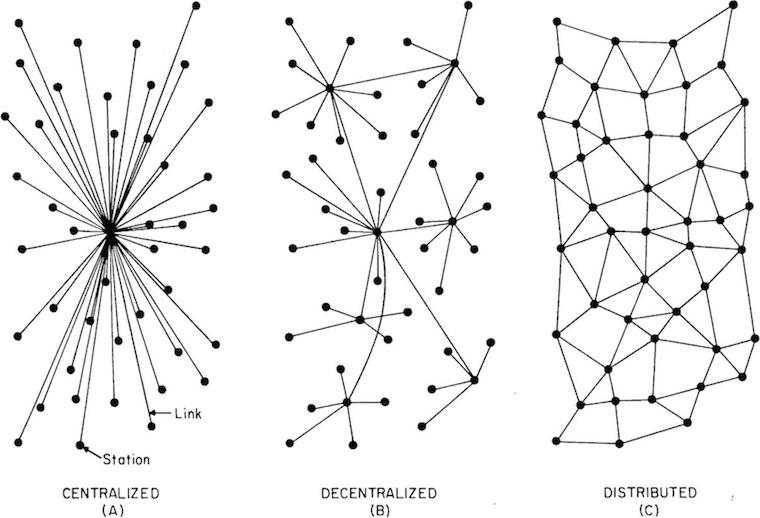 source: j4n
source: j4n
All nodes are equal and so are all routes. Cyclist route themselves. In that way the network works quite like… the internet.
We could call it the democratic network, because it treats everyone as equals. Or we could call it the liberal network (that would be very dutch). Or—in a post‐modern way—we could call it the atomised network.
I simply call it the bicycle route network of the Netherlands.

Labels: infrastructure, lecture, practical, top story

If you like to ask Peter one burning question and talk about it for ten minutes, then check out his available officehours.
What is Peter up to? See his /now page.
- info@mmiworks.net
- +49 (0)30 345 06 197
- imprint

 Peter Sikking
Peter Sikking